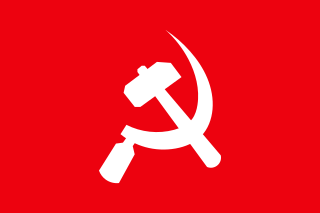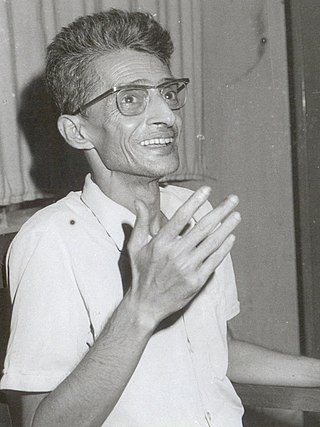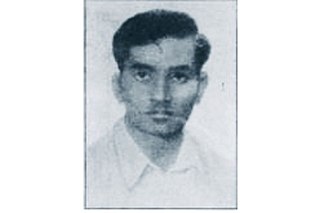
The Communist Party of India (Marxist–Leninist) (CPI (ML)) was an Indian communist party formed by the All India Coordination Committee of Communist Revolutionaries (AICCCR) at a congress in Calcutta in 1969. The foundation of the party was declared by Kanu Sanyal at a mass meeting in Calcutta on 22 April, Vladimir Lenin's birthday. Later the CPI(ML) party splintered into several Naxalite groups.

Charu Mazumdar, popularly known as CM, was an Indian Communist leader, and founder and General Secretary of the Communist Party of India (Marxist-Leninist). Born into a progressive landlord family in Siliguri in 1918, he became a Communist during the Indian Independence Movement, and later formed the militant Naxalite cause. During this period, he authored the historic accounts of the 1967 Naxalbari uprising. His writings, particularly the Historic Eight Documents, have become part of the ideology which a number of political parties in India.

The Communist Party of India (Maoist) is a banned Marxist–Leninist–Maoist communist political party and militant organization in India which aims to overthrow the "semi-colonial and semi-feudal Indian state" through protracted people's war. It was founded on 21 September 2004, through the merger of the Communist Party of India (Marxist–Leninist) People's War (People's War Group) and the Maoist Communist Centre of India (MCCI). The party has been designated as a terrorist organisation in India under the Unlawful Activities (Prevention) Act since 2009.
Kanu Sanyal was an Indian communist politician. In 1967, he was one of the main leaders of the Naxalbari uprising and in 1969 he was one of the founding leaders of Communist Party of India (Marxist-Leninist). Sanyal died by suicide on 23 March 2010.
The Maoist Communist Centre (MCC) was one of the largest two armed Maoist groups in India, and fused with the other, the People's War Group in September 2004, to form the Communist Party of India (Maoist).
Kondapalli Seetharamaiah was a senior communist leader and Maoist organizer in India.
The Historic Eight Documents are a set of eight monographs authored by the Indian Maoist revolutionary Charu Majumdar that outline the ideological principles on which the Naxalite militant communist movement in India was based. They laid down the idea that the Indian State was a bourgeois institution and that the main Indian communist parties had embraced revisionism by agreeing to operate within the framework of the Constitution of India. They urged a Maoist protracted people's war to overthrow the Indian State. They denounced the Soviet Union both for being revisionist, as well as for supporting the Indian State.

The Naxalite–Maoist insurgency is an ongoing conflict between Maoist groups known as Naxalites or Naxals and the Indian government. The influence zone of the Naxalites is called the red corridor, which has been steadily declining in terms of geographical coverage and number of violent incidents, and in 2021 it was confined to the 25 "most affected" locations, accounting for 85% of Left Wing Extremism (LWE) violence, and 70 "total affected" districts across 10 states in two coal-rich, remote, forested hilly clusters in and around the Dandakaranya-Chhattisgarh-Odisha region and the tri-junction area of Jharkhand, Bihar, and West Bengal. The Naxalites have frequently targeted police and government workers in what they say is a fight for improved land rights and more jobs for neglected agricultural labourers and the poor.
The April 2010 Dantewada Maoist attack was an 6 April 2010 ambush by Naxalite-Maoist insurgents from the Communist Party of India (Maoist) near Chintalnar village in Dantewada district, Chhattisgarh, India, leading to the killing of 76 CRPF policemen and 8 Maoists — the deadliest attack by the Maoists on Indian security forces.
Jangal Santhal, also known as Jangal Santal was an Indian political activist.
The Central Organising Committee, Communist Party of India (Marxist–Leninist) Party Unity, more commonly known as CPI(ML) Party Unity or simply 'Party Unity', was a communist party in India 1982-1998. Narayan Sanyal alias Naveen Prasad was the general secretary of the party. Party Unity was the official organ of the party. CPI(ML) Party Unity was one of the predecessors of the Communist Party of India (Maoist).
Satyanarayan Singh was an Indian communist politician. Singh was one of the early leaders of the Communist Party of India (Marxist-Leninist), being its secretary in Bihar.
Lal Jhanda Dal was a communist organization in West Bengal, India. It was one of several Maoist splinter groups that was active in West Bengal as of the late 1960s and early 1970s. The group was led by Swadesh Mitra. Swadesh Mitra had been a leader of the Communist Party of India (Marxist) in Calcutta, but formed part of an oppositional tendency. The Bolshevik Core tendency that Mitra belonged to had maintained contacts with the radicals in North Bengal.
Sushital Ray Chowdhary was an Indian Communist intellectual and founder member of Communist Party of India (Marxist-Leninist). He was the editor of the organs of the CPI, CPI(M) and CPI(ML). He eventually fell out with the mainstream Charu Majumdar group and died of a heart attack in March, 1971.
The Srikakulam peasant uprising occurred from 1967 to 1970, in Srikakulam district, Andhra Pradesh, India. The Naxalbari uprising at the beginning of the Naxalite movement during the 1960s inspired the upsurge.

Naxalbari uprising was an armed peasant revolt in 1967 in the Naxalbari block of Siliguri subdivision in Darjeeling district, West Bengal, India. It was mainly led by tribals and the radical communist leaders of Bengal and further developed into the Communist Party of India (Marxist–Leninist) in 1969. The armed struggle became an inspiration to the Naxalite movement which rapidly spread from West Bengal to other states of India creating division within the Communist Party of India (Marxist) - India's primary communist party.
Central Organising Committee, Communist Party of India (Marxist–Leninist) was a communist party in India, one of the main splinter factions of the original Communist Party of India (Marxist–Leninist). COC, CPI(ML) occupied a middle position between the pro-Charu Majumdar group led by Mahadev Mukherjee and the anti-Majumdar group led by Satyanarayan Singh. Failing to articulate a common ideological position, COC, CPI(ML) soon suffered internal divisions and splits. Two of the splinter groups of COC, CPI(ML) in Andhra Pradesh are predecessors of the present-day Communist Party of India (Maoist).
Narayan Sanyal commonly known as Bijoy da and Naveen Prasad was a Maoist ideologue and a Politburo member of the Communist Party of India (Maoist). He was one of the earliest comrade of Naxal leader Charu Majumdar and member of undivided Communist Party of India (Marxist–Leninist). It is claimed that at the time of arrest Narayan Sanyal was next only to CPI (Maoist) the then general secretary Muppala Lakshmana Rao alias Ganapathy.

Deo Kumar Singh, commonly known by his nom de guerre Arvind Ji, Vikash Ji and Sujeet Ji, was an Indian politician who was the leader of the Indian Maoist movement and the Politburo Member of Communist Party of India (Maoist), a banned communist party in India. He spent his life as a student leader, a mass organiser and later led and strategised the guerrilla warfare against the Indian state.

Jagdish Mahto was an Indian communist activist. He was a naxal leader who led the 1970 Bhojpur uprising in the landlord-dominated Bhojpur region of Bihar. He was a member of the Communist Party of India (Marxist–Leninist), an organisation which was leading the Naxalite insurgency against the Government of India. He also fought against the upper-caste landlords for the cause of lower-caste people. Mahto, also called Master Saheb, was a member of the Bihar State Committee of CPI(M–L) and one of the founding leaders of the party in Bhojpur.







